Chasing the sun to celebrate the new year: Korea’s best spots to catch breathtaking sunsets and sunrises

The sunset seen from Hongpo Village in Geoje Island, South Gyeongsang. The weather decides whether one can see the popular omega-shaped sun at sunset.
However, whatever mood people are in, many regard the sun as signifying their closure with the past and anticipation of the future. Those looking to savor the final moments of the year will find their way to either western or southern Korea to watch the last sunset of the year, while those eager to turn over a new leaf will rush out to watch the first sunrise of the New Year in the eastern part of the country.
For those looking for ways to avoid the inevitable crowds reveling in the New Year, the JoongAng Ilbo ventured out to different parts of Korea to find secluded yet picturesque spots to celebrate the sun. Those looking for a perfect pink sky in the late afternoon should venture down to Geoje Island, South Gyeongsang, while others longing to see a grandiose sunrise should head out to Mount Taebaek in Gangwon.
Saying goodbye to the past
One of the least-known spots to see the sunset is Hongpo Village, located in the southernmost point of Geoje Island, South Gyeongsang. The very quiet fishing town can be reached by driving down unpaved roads covered in gravel.
After getting out of the downtown area, the open South Sea welcomes visitors. It takes about an hour from the shipbuilding center of the island to Hongpo Village, but the ride is never dull as it passes many of the popular sightseeing spots such as Haegeumgang and Mongdol Beach, known for its pebble-filled beach. One can also see Oe Island, famous for its arboretum.
“Our town has two things to brag about: one is the sunset that dyes the sky red, and the other are the rainbows that emerge each and every season,” said 54-year-old Park Pal-wan, the village chief.
Park said there are two spots where people can best appreciate the sunset: Byeongdaedo Observatory and Hongpo Village Harbor.
Byeongdaedo Observatory is located on a cliff about one kilometer away from Hongpo Village to the east. From the observatory, visitors can take a good look at the islands located nearby - even the Japanese island Tsushima comes within their view.
The view of the ocean is amazing from the observatory, but the sunset can be better captured at the harbor, as visitors can sit there until the sun really goes down over the horizon. The sun started to set a little after 4:50 p.m., and the sky becomes a brilliant shade of red. It takes about 25 minutes for the sun to fully disappear. If you are lucky, you may get a chance to see the sun make an omega shape, considered the most beautiful shape for the setting sun. It only lasts about 10 seconds, so watchers need to focus on not missing it.

Top: The view of Mongdol Beach, a rare beach in Korea with pebbles instead of sand, located in Geoje Island, South Gyeongsang. Below: Dried cod near the harbor on the island, which is commonly enjoyed during the winter. [IM HYUNG-DONG]
Mount Taebaek, with an altitude of 1,567 meters (5,142 feet), is known as the mountain of the winter season. It is not as colorful as Mount Seorak (1,708 meters) nor as tall as its provincial neighbor Mount Jiri (1,915 meters), but with its stunning snow-covered landscape, the mountain has gained popularity among hikers looking for a good view for their winter hikes.
The mountain has historically been considered a sacred place as Cheongjedan, where rituals to honor the founding father of Korea, Dangun, were held, is located in the mountain. For centuries, many Koreans have used the scared space to connect with their ancestors by doing rituals there. There are also some records from the times of the Silla Dynasty (57 B.C.-A.D. 935), one of Korea’s ancient kingdoms, that show people participating in memorial rituals. Additionally, activists fighting for Korea’s independence from Japanese colonial rule (1910-1945) went into hiding in the mountain and did rituals there as well.
Leaving at 4 a.m. to catch the sunrise, you first need to choose which trail is that hike that best suits you. The hiking path at the mountain diverges into three different trails. The path from the Yuil Temple is the easiest one, followed by the trail that goes by Danggol Valley and Baekdan Temple. The path from the Yuil Teple is about seven kilometers long round trip, which is relatively short, and the beginning of the trail is wide enough for a car to pass through.
Although the trail itself is quite an easy one to walk during the daytime, it is very dark early in the morning, and hikers have to rely on their own flashlights to get towards the open space. After hikers pass an intersection in front of the Yuil Temple, the incline becomes a bit tougher. The deeper you go, the darker it gets. If snow has covered the trail, the reflection of the moonlight helps illuminate the way. The trail is a good place to organize your thoughts, if you are not too short of a breath, as the only thing you will hear is your footsteps in the snow. It takes about two hours to the top.
It isn’t necessary to get an open spot early, but it gives you enough time to prepare before the sun starts to show its face. Plus, getting there early will help you find a good spot to appreciate the view without being bothered by the crowd. Around 7 a.m., the horizon will start to turn red, and the sun will slowly spread its light across the other mountain tops in view.

Top: Mount Taebaek covered in snow. The mountain is particularly popular for its snowscape in the winter. Bottom: Visitors can fill their stomachs after watching the sunrise with the area’s famous hanwoo, or Korean beef.
There is a saying that three generations of a family need to do good deeds to see the sun rising above the ocean - meaning that looking at a truly beautiful sunrise isn’t an easy task.
If you do get to see this rare scene, many automatically reach for their cameras or phones to take a picture so that they can capture the beauty of the moment.
Diligence is required if you want to get the best possible picture. You should arrive at your spot at least 40 minutes before sunrise to set up a good angle to take photos and set up your camera and tripod. It is also helpful to have a gradation filter, which can minimize the exposure difference between the sky and the land.
If you want your sun to take up the majority of your photo, use a telephoto lens. To capture more of the background around the sun, use a wide-angle lens. If you make your exposure level one-stop shorter, then you can get the round-shape of the sun. The sensitivity level should be set at low or middle range if you don’t want to have too many floating particles captured in the image. If there is a particular item you want to have in your photo, then have your iris set higher than f8. It is better to set your shutter speed after you set your iris.
Trying to focus on the sun itself will only hurt your eyes. It is more convenient to have the focus on an item in front of the sun to get the clear image of the sun.

The sunrise captured from Janggun Peak on Mount Taebaek, Gangwon, known for its snow-capped peaks. [IM HYUNG-DONG]
Of course, going up to the peak to see the sunrise on the New Year’s Day cannot guarantee you getting the perfect sun, but if you want to capture your own sunrise photo another day, make sure you check the weather. A good day to watch the perfect sun is when the temperature of the previous day before was a lot higher.
BY LEE SUK-HEE, BAEK JONG-HYUN AND IM HYUNG-DONG [summerlee@joongang.co.kr]
[커버스토리] 한려해상서 묵은 때 벗고, 백두대간서 새 기운 받고
연말연시 해넘이·해맞이 여행
2016년에도 헌 해를 보내고 새 해를 맞으러 떠난다. 헌 해를 보내려고 남해안으로 내려갔고 새 해를 맞으려고 눈 쌓인 산을 올랐다. 경남 거제 홍포마을은 아직 낯선 해넘이 장소다. 찾는 이가 많지 않아 연말에도 인파가 덜하다. 그러나 해 넘어가는 풍경은 여느 일몰 명소 못지 않았다. 반면에 태백산(1567m) 해맞이는 워낙 유명하다. 태백산 정상에서 일출을 보면 좋은 기운을 받는다고 소문이 자자한 터였다. 마침 태백산은 지난 8월 국립공원으로 지정됐다.
남해를 붉게 물들이다 거제도 홍포마을 일몰
인천 강화도 장화리해변, 충남 안면도 꽃지해변, 전북 부안의 채석강, 전남 해남의 땅끝마을, 경남 통영의 달아공원 등 전국의 해넘이 명소는 연말마다 인파로 몸살을 앓는다. 넘어가는 해를 보며 차분하게 한 해를 정리하겠다는 생각이 인파에 이리 치이고 저리 치이다 보면 싹 가시고 만다.
아직 세상이 잘 모르는 해넘이 장소를 알아보다 찾아낸 곳이 경남 거제도 남부면의 홍포마을이다. 거제도에서도 가장 남쪽에 틀어박힌 포구이고, 자갈길을 달려야 닿을 수 있는 한갓진 어촌이다. 거제도 남쪽 해안 중앙에 있어서 홍포마을은 섬 입구에서도 자동차로 한 시간 남짓 달려야 다다를 수 있다.
거제도 입구에서 14번 국도~1018번 지방도로로 이어진 동쪽 해안도로를 달리다 보면 제일 먼저 거제도의 상징인 조선소가 나타난다. 한때 거제도는 ‘지나가는 개도 1만원 지폐를 물고 다닌다’는 우스개가 돌 정도로 잘 사는 고장이었지만 지금은 조선 경기 불황으로 힘든 나날을 보내고 있다.
시내를 벗어나자 왼편으로 남해 바다가 시원스레 펼쳐졌다. 조선소를 지나 홍포마을까지 가는 1시간 동안 수선화 명소인 공곶이를 비롯해 바람의 언덕·해금강·몽돌해변 등 거제 8경으로 꼽히는 유명 관광지가 잇달아 나타났다. 동백꽃 명소 지심도·내도와 수목원으로 유명한 외도도 나타났다 사라졌다. 홍포마을에 도착하자 박팔완(54) 이장이 마중을 나왔다.
“우리 마을은 자랑이 두 가지 있습니다. 한려해상을 붉게 물들이는 일몰과 사시사철 피어나는 무지개입니다. 그래서 옛날에는 무지개 마을이라고 불렸습니다.” 박 이장의 말대로 홍포마을을 풀어 쓰면 ‘무지개(虹)가 뜨는 물가(浦) 마을’이라는 뜻이 된다.
박 이장은 일몰 포인트가 두 곳 있다고 했다. 병대도 전망대와 홍포마을 선착장이다. 병대도 전망대는 홍포마을에서 동쪽으로 1㎞쯤 떨어진 절벽에 있었다. 전망대에서 내려다보니 한려해상국립공원에 있는 수많은 섬이 수평선 위로 고개를 내밀고 있었다. 대병대도·소병대도·가왕도·소매물도·대매물도 등 10여 개 섬이 손에 잡힐 듯 가까웠다. 왼쪽으로는 멀리 쓰시마(對馬島)도 보였다.
전망대에서 조망하는 바다 풍경은 예뻤지만 일몰 포인트로는 선착장이 나아 보였다. 전망대에서와 달리 바다로 빠지는 해를 감상할 수 있어서였다. 지난 16일에도 선착장에서 바라보는 일몰이 훨씬 아름다웠다. 예상대로 소지도 오른쪽 바다로 해가 떨어지고 있었다. 오후 4시 50분이 지나자 소지도 주변이 붉게 물들기 시작했다. 영하의 날씨 탓에 차갑고 강한 바람이 불어 구름도 거의 없었다. 최고의 일몰 장면으로 꼽는 오메가(Ω) 모양의 일몰이 가능해 보였다.
일몰 예정 시간인 오후 5시15분이 가까워지자 해는 천천히 수평선 너머로 숨기 시작했다. 태양의 밑동이 바다에 닿자 기다렸던 오메가 일몰이 완성됐다. 10초 남짓한 장면이었지만 지금 껏 본 일몰 중 최고였다. 내년에는 왠지 좋은 일만 일어날 것 같은 기운이 들었다.
*여행정보
서울시청에서 거제도 홍포마을까지는 약 420㎞ 거리로 자동차로 6시간쯤 걸린다. 홍포마을에 펜션이 6곳 있는데 연말에는 객실 요금이 크게 뛴다. 4인 가족이 잘 수 있는 부엌 딸린 객실이 1박에 15만원이다.
대구는 겨울 거제도를 대표하는 생선이다. 대구는 1년 내내 잡히지만 겨울 대구가 살이 차올라 윗길로 친다. 거제도 외포항이 국내 최대 대구 산지다. 겨울 외포항에서 대구탕을 주문하면 생대구를 잡아 끓여준다. 1그릇 1만5000원. 겨울에만 먹을 수 있는 대구회는 1인 3만원. 등대식당 055-636-6426. 식당에서 생대구도 판다. 6㎏ 5만원.
잠에서 깨는 산맥 태백산 일출 산행
태백산(1567m)은 겨울 산이다. 설악산(1708m)만큼 화려하지 못하고 지리산(1915m)만큼 몸집도 크지 않지만 겨울에는 단연 태백산을 으뜸으로 친다. 백두대간의 육중한 산세에서 흰 눈이 성성하게 빛나고 산마루 주목에서 눈꽃이 피어나면 지상의 풍경을 넘어서는 선경을 연출한다.
태백산은 예부터 ‘민족의 영산(靈山)’ ‘하늘의 산’으로 불렸다. 단군을 모신 성전과 하늘에 제를 올리는 천제단이 태백산에 있다. 신라 때 태백산에서 하늘에 제사를 올렸다는 기록이 『동국여지승람』 『삼국사기』 등에 전해온다. 구한말과 일제 강점기에는 독립운동가가 은거하며 제를 올렸다는 기록도 있다. 집안의 우환을 벗으려고 또 나랏일을 근심하는 마음으로 우리 선조는 구태여 이 산을 오르고 또 올랐다. 그러니까 태백산 산등성이와 골짜기에는 우리 민족의 애환이 켜켜이 얹혀 있다.
오늘도 마찬가지다. 매년 정초가 되면 수많은 사람이 깜깜한 새벽부터 줄지어 이 산을 오른다. 그리고 정상에 서서 먼동을 바라본다. 예나 지금이나 태백산을 오르는 우리네의 마음은 같다. 하늘의 기를 받아 이 험한 세상 버텨내고 싶은 마음뿐이다.
week&도 해를 맞으러 태백산을 올랐다. 새벽 4시. 유일사 주차장을 기점으로 산행을 시작했다. 태백산 산길은 크게 세 갈래로 나뉜다. 유일사와 당골계곡, 백단사를 들머리로 삼을 수 있다. 그 가운데 가장 쉬운 산길이 유일사 코스다. 왕복 7㎞ 길이로 비교적 거리가 짧은데다 길 초입은 자동차도 지날 수 있을 만큼 폭이 넓고 완만하다.
하나 캄캄한 새벽이었다. 랜턴에 의지해 살금살금 비탈로 들었다. 유일사 앞 갈림길에서 본격적으로 경사가 가팔라졌다. 산으로 들수록 시야가 더 어두워졌다. 위안은 길에 깔린 눈이었다. 밤새 내린 눈이 산길에 누워 흐릿하게나마 길을 밝혔다. 눈 밟는 소리와 가쁜 숨소리만이 새벽의 고요를 흔들었다.
장군봉에서 천제단까지의 능선은 바람이 독했다. 칼바람에 살갗이 아렸다. 그야말로 거칠 것 없는 백두대간의 등허리였다. 장군봉 아래 주목 군락에 몸을 숨기니, 그나마 바람이 덜했다. 시선을 동쪽 하늘에 던져둔 채 속절없는 기다림의 시간이 이어졌다.
오전 7시. 동쪽 하늘이 붉게 물들기 시작했다. 먼동이 트려는 신호다. 구름에 가렸지만 해는 분명 떠오르고 있었다. 서서히 함백산·두타산·매봉산·문수봉 등 백두대간의 봉우리들이 일제히 고개를 들었다. 산마루 주목 군락의 고사목도 기지개를 켰다. 태백산의 정기를 받아서인지, 유난히 드센 바람 탓인지 주목은 하나같이 신묘한 모습이었다. 이리저리 휘어지고 꺾어지기는 했으나 주목은 하나같이 꼿꼿이 서 있었다.
구름 위로 해가 뜨자 백두대간이 시원하게 열렸다. 간밤의 눈과 서리가 만든 상고대로 온 세상이 환했다. ‘가장 크게 밝은’ 태백산(太白山)의 이름 그대로였다. 무엇이든 빌고 싶은 마음이 절로 일었다. 천제단에 올랐다. 바람이 거셌지만 매서움은 덜했다. 고개 드니 태양빛이 얼굴을 내리쬐고 있었다.
*여행정보
태백산 산행 코스 세 개 중에서 week&은 유일사 코스로 산을 탔다. 유일사 주차장~장군봉~천제단으로 이어지는 편도 3.5㎞ 코스로 정상까지 약 2시간이 걸린다. 새해 첫날은 4시 30분 전에 산행을 시작해야 명당 자리에서 일출을 맞을 수 있다. 랜턴과 스틱ㆍ아이젠은 필수다. 바람이 거세 마스크도 챙기는 게 좋다. 지난 8월 태백산이 국립공원이 되면서 입장료가 사라졌다. 당분간 주차비도 안 받는다. 태백산국립공원 033-550-0000.
태백 시내에 한우 식당 약 40곳이 몰려 있는데 황지동의 ‘태백한우골(033-554-4599)’이 태백 주민이 꼽는 맛집이다. 사흘 숙성한 한우생갈비살(200g 2만8000원)을 연탄불에 구워 먹는데 육질이 부드럽다. 된장국에 면을 넣어 끓인 된장소면(4000원)도 별미다.
글=이석희·백종현 기자 seri1997@joongang.co.kr
사진=임현동 기자 hyundong30@joongang.co.kr










with the Korea JoongAng Daily
To write comments, please log in to one of the accounts.
Standards Board Policy (0/250자)